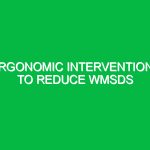Work-related Musculoskeletal Disorders (WMSDs) encompass a range of injuries and disorders affecting muscles, tendons, ligaments, nerves, and spinal discs. These conditions often arise from repetitive motions, awkward postures, or excessive force, making them a significant concern in the Health, Safety, and Environment (HSE) domain. Effectively reporting and managing the symptoms of WMSDs is crucial not just for the well-being of employees but also for the overall productivity and efficiency of organizations. Let’s delve deeper into understanding these disorders, the associated risks, and the best practices for management and reporting.
Understanding WMSDs: A Closer Look
WMSDs can manifest in various forms, including carpal tunnel syndrome, tendonitis, and lower back pain. These conditions typically develop gradually, often going unnoticed until they significantly impact an individual’s ability to perform their job. The relevance of WMSDs in the HSE field cannot be overstated—injuries of this nature account for a substantial percentage of workplace injuries, leading to lost workdays and decreased productivity.
For instance, a factory worker repeatedly assembling components might experience wrist pain, which could escalate into a more severe condition if not addressed promptly. This scenario illustrates the critical importance of recognizing and reporting symptoms early. The sooner symptoms are addressed, the better the chance of effective management and recovery.
Hazards and Risks Associated with WMSDs
Identifying the hazards associated with WMSDs is the first step in effective reporting and management. Common risks include:
1. Repetitive Motion
Repetitive tasks can lead to fatigue and strain on specific muscle groups. For example, administrative workers often spend long hours typing, which can contribute to conditions like carpal tunnel syndrome. The key here is not just to identify the task but to evaluate how often it occurs and the duration of such activities.
2. Poor Ergonomics
Workspaces that lack ergonomic design can lead to awkward postures. A poorly designed workstation can force an employee to reach awkwardly for tools or strain to see a screen, leading to neck and back pain. Understanding the principles of ergonomics and implementing them in the workplace can help mitigate these risks.
3. Heavy Lifting
Jobs that require lifting heavy objects can increase the risk of back injuries. Proper training on lifting techniques and the use of assistive devices is crucial. A warehouse worker lifting boxes without adequate training may suffer a serious back injury, a risk that can be significantly reduced with the right precautions.
4. Vibration Exposure
Workers using handheld tools may experience vibration exposure, leading to conditions like Hand-Arm Vibration Syndrome (HAVS). This condition can cause numbness and tingling in the fingers and hands, eventually affecting grip strength and dexterity.
Recognizing these hazards is essential in promoting a culture of safety within the workplace. But awareness alone isn’t enough; action must be taken to manage these risks effectively.
Best Practices for Reporting and Managing Symptoms of WMSDs
Implementing best practices for reporting and managing WMSDs can create a safer work environment. Here are some actionable steps:
1. Encourage Open Communication
Employees should feel comfortable reporting symptoms without fear of repercussions. Creating a culture that values health and safety encourages workers to speak up about their concerns. For example, a manufacturing plant might hold regular safety meetings where employees can share their experiences and suggest improvements.
2. Regular Training and Education
Training sessions on ergonomics, safe lifting techniques, and the importance of reporting symptoms can empower employees. A well-informed workforce is more likely to recognize early signs of WMSDs and take proactive measures. This could involve workshops or online courses tailored to specific job functions.
3. Implement Ergonomic Assessments
Conducting regular ergonomic assessments can identify potential hazards in the workplace. An ergonomic specialist might analyze a workstation to determine if adjustments are necessary. Simple changes, like adjusting chair height or monitor position, can significantly reduce strain and discomfort.
4. Utilize Reporting Tools
Utilizing digital tools for symptom reporting can streamline the process. Software applications that allow employees to report symptoms in real-time can help management track and address issues promptly. For instance, a construction company might implement a mobile app where workers can log discomfort or pain immediately after noticing symptoms.
Safety Precautions to Minimize Risks
Beyond reporting, implementing safety precautions is essential for managing WMSDs effectively. Here are some key strategies:
1. Job Rotation
Rotating employees through different tasks can reduce the risk of repetitive strain injuries. For example, in a production line, workers might alternate between assembly, packing, and quality control roles to minimize exposure to repetitive tasks.
2. Provide Personal Protective Equipment (PPE)
In certain industries, PPE can be vital in managing risks associated with WMSDs. For instance, workers exposed to vibration should use tools designed to minimize vibration exposure, like anti-vibration gloves. These small adjustments can make a significant difference in overall comfort and health.
3. Promote Stretching and Breaks
Encouraging regular breaks and stretching exercises can alleviate muscle tension. Simple stretches can be incorporated into daily routines, allowing employees to rest and recover their muscles. A simple ten-minute break every hour can rejuvenate workers and improve productivity.
4. Engage in Data Analysis
Analyzing data related to WMSDs can help identify trends and areas for improvement. Keeping track of reported symptoms, injury rates, and productivity levels can provide valuable insights for developing tailored interventions. For instance, if certain departments report higher injury rates, management can investigate further and implement targeted training or ergonomic changes.
Regulations and Standards Governing WMSDs
Several regulations and standards govern the management of WMSDs in the workplace. Understanding these guidelines is essential for compliance and ensuring worker safety:
1. Occupational Safety and Health Administration (OSHA)
OSHA provides guidelines and standards for workplace safety, including ergonomics. While OSHA does not have a specific ergonomics standard, it encourages employers to reduce ergonomic hazards. Organizations must adhere to OSHA’s General Duty Clause, which requires them to provide a workplace free from recognized hazards.
2. National Institute for Occupational Safety and Health (NIOSH)
NIOSH conducts research and makes recommendations for the prevention of work-related illness and injury. Their ergonomic guidelines can help employers design safer workplaces and reduce the incidence of WMSDs.
3. American National Standards Institute (ANSI)
ANSI provides standards related to workplace ergonomics. Adhering to these standards can enhance workplace safety and reduce the risk of WMSDs. Implementing ANSI guidelines can demonstrate a commitment to employee health and safety.
Conclusion: The Importance of Proactive Management
Reporting and managing symptoms of WMSDs is not just a regulatory requirement; it’s a fundamental aspect of fostering a safe and healthy workplace. By understanding the risks, implementing best practices, and adhering to regulations, organizations can significantly reduce the incidence of these disorders. It’s about creating a culture where employee well-being is prioritized, leading to a more productive and engaged workforce. In the end, addressing WMSDs through effective reporting and management is an investment in the most valuable asset of any organization: its people.


